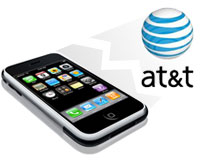As AT&T’s exclusive partnership to offer the iPhone dwindles to its final days, many are already speculating about how Apple’s deal to sell the device through Verizon will affect AT&T’s bottom line. Will customers jump ship in droves to switch carriers from AT&T to its longtime rival? Or can AT&T offer those users enough incentives to stay (or disincentives to switch), and clear up lingering doubts about the strength of its network?
While conventional wisdom is that AT&T will face a challenging 2011 without sole rights to sell the iPhone, say Wharton experts, the company still has a chance to minimize any damage inflicted by Verizon. After years of rumors that a deal with Verizon was imminent, the carrier and Apple made it official on January 11 with the announcement that a Verizon iPhone will go on sale beginning February 10. Pricing for the device will be the same as AT&T — $199 for a 16GB device and $299 for the 32GB version. Verizon has said it will make data plan pricing for the iPhone available at a later date. “Verizon Wireless customers have told us they can’t wait to get their hands on iPhone 4,” Apple chief operating officer Tim Cook said at the launch event, which was described as the beginning of a long partnership between the two companies.
Indeed, analysts say there is a lot of pent-up demand among Verizon customers for the iPhone. They estimate that Verizon Wireless will sell anywhere from 10 million to 12 million iPhones this year. Less clear is how many of those Verizon iPhones will go to former AT&T customers (who need to purchase a new device in order to switch carriers). According to research firm comScore, Verizon Wireless currently has 31% of the wireless carrier market followed by AT&T at 27%. However, AT&T leads in smartphone market share with 38% followed by Verizon Wireless at 27%.
Although AT&T’s growth has been powered by the iPhone since the company’s exclusive deal with Apple was introduced in 2007, AT&T has also recently worked to diversify its offerings by introducing devices powered by Google’s Android operating system — many of which are also offered by Verizon. After February 10, the two rivals, who are also the dominant carriers in the United States, will essentially sell the same slate of products. The winner of what Wharton experts expect to be an all-out marketing war will be the company that offers the strongest network and best customer service.
‘Fastest’ vs. ‘Most Reliable’
Verizon’s event to launch the iPhone — held at Lincoln Center in New York — signaled that the battle with AT&T had commenced. Verizon president and chief operating officer Lowell McAdam told the PBS Nightly Business Report on January 11 that his company would welcome every AT&T customer who defects.
McAdam also touted Verizon as having the “most reliable” network of any carrier, a direct hit at AT&T. The massive data consumption of iPhone users proved a challenge for AT&T’s infrastructure, and the carrier has had trouble delivering consistent coverage in cities like New York and San Francisco.
“The iPhone brought a lot of business to AT&T, but also gave the company a lot of headaches,” says Gerald Faulhaber, an emeritus professor of business and public policy at Wharton. “It was clear that AT&T’s network wasn’t robust enough for the iPhone…. I don’t see the iPhone exclusive as a wild success for AT&T.”
Verizon frequently mocks AT&T’s issues with dropped calls in its marketing, and AT&T was rated the worst among wireless carriers in a recent Consumer Reports survey. For its part, AT&T claims to have the fastest network, and the company is also quick to point out that Verizon’s infrastructure will not allow consumers to use data and voice applications at the same time.
On January 5, John Stankey, president and CEO of AT&T Business Solutions, acknowledged that the carrier is “not where we need to be” on network coverage, pointing to supply issues with the equipment needed to upgrade coverage in certain areas as one example. “I would say that we will bounce back in the majority of the U.S. very, very quickly during the first part of this year as that material gets put into service over the next several weeks,” said Stankey. “We still have some large markets that remain a challenge for us. I think that’s the nature of running a network.”
The network troubles create potential for “an immediate shift of one group of users,” from AT&T to Verizon, says Andrea Matwyshyn, a legal studies and business ethics professor at Wharton. “The users that rely on their mobile communications day-to-day will search for the most reliable connection.”
AT&T’s challenge will be to market a powerful network and invest to back up its claims of speed and improved reliability. “AT&T’s strategy in both wireline and wireless is the same: Don’t spend to be the best in terms of quality, just offer something good enough, and win on margins,” notes Kevin Werbach, a Wharton professor of legal studies and business ethics. “Verizon will cannibalize many AT&T Wireless customers when it gets the iPhone, but it will also take on substantial phone subsidy and network upgrade costs.”
At the Consumer Electronics Show in Las Vegas on January 5, AT&T president and CEO Ralph de la Vega said AT&T was also stepping up its roll-out of high-performance 4G service known as Long-Term Evolution (LTE). AT&T expects to begin offering LTE service in the middle of 2011. Verizon has already launched its LTE network, although the iPhone will initially be available only on the company’s older, but more broadly available, 3G network.
Even if AT&T improves its network, it is unclear that customers will acknowledge any improvement. “Reputation is a funny construct,” Matwyshyn points out. “A portion of users will only follow the first half of the story, and won’t [attempt] to find out if the carrier mitigated the problems.”
The wild card for AT&T is that “it remains to be seen what the efficiency of the Verizon network is with handling the data demands” of the iPhone, says Jehoshua Eliashberg, a Wharton marketing professor. A poor performance by Verizon would make AT&T’s missteps less glaring. If Verizon’s network performs well when faced with the burden of increased data guzzling, however, it would further cement AT&T’s reputation for poor performance. “If everyone at AT&T runs to Verizon, we’ll see if their network can handle the traffic,” notes Kendall Whitehouse, director of new media at Wharton. “If nothing else, the iPhone at Verizon will tease out what the problems are. Is it simply the number of iPhone users, or some structural network problem?”
Locked In or Locked Out?
Despite all the talk about customers who came to AT&T because of the iPhone leaving in droves for Verizon, experts say the real effect may not be as substantial, in part due to a phenomenon called “cognitive lock-in.” This principle dictates that while consumers may complain about a service provider, most never take the step of actually changing to a new one.
“People will complain, but don’t seek a better deal from a competitor,” notes Eliashberg. “Changing [service providers] is a pain in the neck. In the short run, I don’t see too much of a [customer] loss for AT&T.” Wharton marketing professor Peter Fader agrees. “These customers say, ‘If you screw me, I’m out of here,’ but there’s far less switching then there should be.”
Indeed, Piper Jaffray analyst Christopher Larsen estimates that 80% of AT&T’s iPhone customer base are part of family or corporate calling and data plans; these types of plans usually have higher rates of retention.
At the same time, AT&T literally locked in many customers following the most recent iPhone upgrade. Users were allowed to get new phones early, providing they signed a new two-year contract with AT&T. As such, an estimated 75% of AT&T’s iPhone customers have a year or more left on their contracts, according to Piper Jaffray’s Larsen. A switch to Verizon for those customers would mean not only buying a new phone, but also paying a $325 early contract termination fee to AT&T. Due to all of these factors, the real fallout from the Verizon iPhone “won’t play out for two years,” Whitehouse predicts.
According to Fader, AT&T could further use cognitive lock-in to its advantage. Instead of trying to entice customers into multi-year contracts, “why not lower [early contract] exit fees so you can show people that AT&T stands by the relationship?” Fader asks. “People don’t want to feel like they are being held hostage.” Some customers may leave if AT&T offered such a promotion, “but most would stay,” notes Fader. “AT&T would look like it is standing tall.”
Selling on Service
Now that AT&T and Verizon have similar phone line-ups, “they will have to compete on service, speeds, contract terms and price,” says David Hsu, a management professor at Wharton. “The category of smartphones is going to become more commoditized over the next couple of years.”
In many respects, wireless carriers are expected to resemble other industries with commodity products: There will be premium pricing for a short period, but no more than that. AT&T and Verizon “want brand loyalty, but want to avoid price competition,” which benefits customers more than it benefits the carriers, Hsu notes. Experts say that AT&T should resist the temptation to cut prices on devices and services to compete with Verizon; instead, they suggest that the company offer variations of its data and calling plans to entice consumers.
It is difficult, however, to pitch data speeds to consumers as a selling point. According to Faulhaber, Verizon’s talk about 4G services is not likely to be a big selling point, assuming the carrier and Apple work to make it available on the iPhone, and may have minimal impact on AT&T. “Companies haven’t figured out how to sell 4G. Verizon has had trouble selling [based on the idea of having] better coverage than AT&T.”
Who wins the game in the end? “The company with the best customer service,” Faulhaber says.



